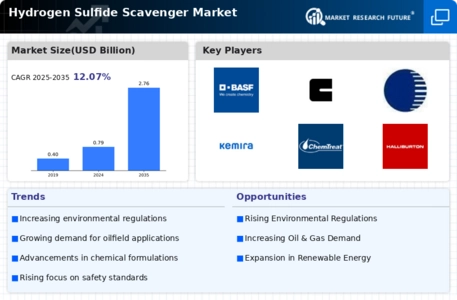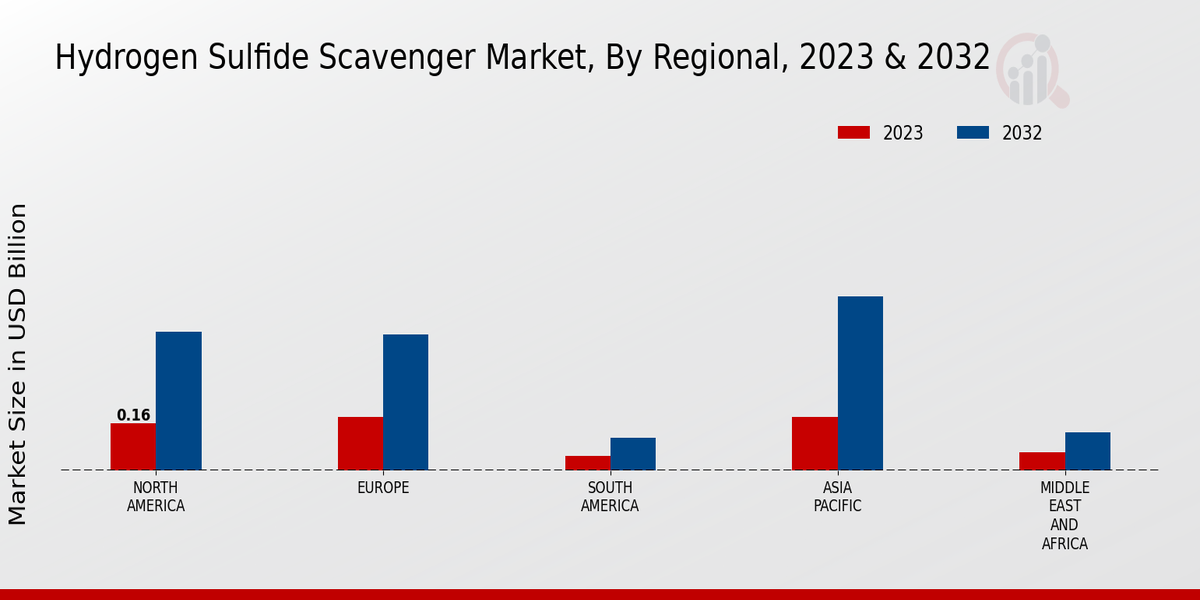Market Growth Projections
The Global Hydrogen Sulfide Scavenger Market Industry is projected to experience substantial growth in the coming years. With an estimated market value of 0.79 USD Billion in 2024, the industry is expected to expand significantly, reaching approximately 2.76 USD Billion by 2035. This growth trajectory indicates a robust CAGR of 12.03% from 2025 to 2035, driven by various factors such as increasing demand from the oil and gas sector, regulatory compliance, and technological advancements. The market's expansion reflects the critical role of hydrogen sulfide scavengers in ensuring safety and environmental protection across multiple industries.
Rising Production of Natural Gas
The surge in natural gas production significantly impacts the Global Hydrogen Sulfide Scavenger Market Industry. As natural gas becomes a preferred energy source, the associated H2S content necessitates the use of scavengers to ensure safe extraction and processing. The market is poised for growth as natural gas production continues to rise, driven by technological advancements and increased exploration activities. This trend not only enhances energy security but also underscores the importance of effective H2S management. The industry's expansion is likely to contribute to the overall market growth, aligning with the projected increase in market value to 2.76 USD Billion by 2035.
Increasing Demand for Oil and Gas
The Global Hydrogen Sulfide Scavenger Market Industry experiences heightened demand due to the oil and gas sector's expansion. As exploration and production activities intensify, the need for effective H2S management becomes paramount. Hydrogen sulfide is a corrosive and toxic gas that poses significant risks in oil and gas operations. The market is projected to reach 0.79 USD Billion in 2024, driven by the necessity for safety and compliance with environmental regulations. Companies are increasingly investing in scavenger technologies to mitigate H2S risks, ensuring operational efficiency and worker safety. This trend underscores the critical role of hydrogen sulfide scavengers in the industry.
Growing Awareness of Environmental Impact
The increasing awareness of environmental issues drives the Global Hydrogen Sulfide Scavenger Market Industry. Industries are becoming more cognizant of their environmental footprint, particularly concerning toxic emissions. The use of hydrogen sulfide scavengers is seen as a proactive measure to mitigate harmful emissions and protect ecosystems. This awareness is prompting companies to invest in cleaner technologies and practices, thereby increasing the demand for effective scavenger solutions. As environmental regulations tighten globally, the market is expected to grow, reflecting a broader commitment to sustainability and responsible resource management.
Regulatory Compliance and Safety Standards
Stringent regulatory frameworks governing emissions and workplace safety significantly influence the Global Hydrogen Sulfide Scavenger Market Industry. Governments worldwide enforce regulations that mandate the use of H2S scavengers to protect workers and the environment. Compliance with these regulations is not only a legal obligation but also a corporate responsibility. As industries strive to meet these standards, the demand for effective scavenger solutions is expected to rise. The market's growth trajectory, with a projected CAGR of 12.03% from 2025 to 2035, reflects the increasing emphasis on safety and environmental stewardship, driving innovation in scavenger technologies.
Technological Advancements in Scavenger Solutions
Innovations in hydrogen sulfide scavenger technologies contribute to the growth of the Global Hydrogen Sulfide Scavenger Market Industry. Advances in chemical formulations and application methods enhance the efficiency and effectiveness of scavengers. Newer products are designed to operate under various conditions, improving their performance in diverse environments. These technological improvements not only increase the effectiveness of H2S removal but also reduce costs associated with H2S management. As the market evolves, companies are likely to adopt these advanced solutions, further propelling the market towards an estimated value of 2.76 USD Billion by 2035.




















